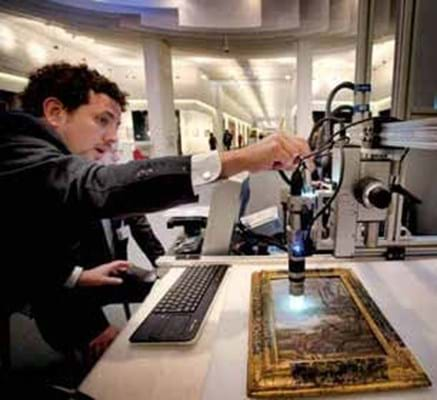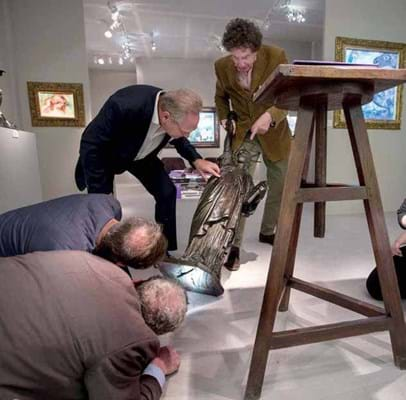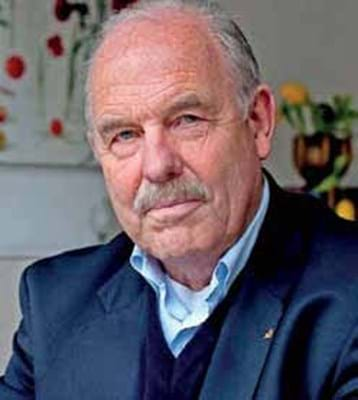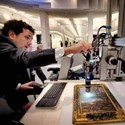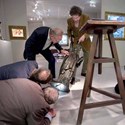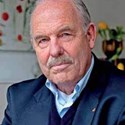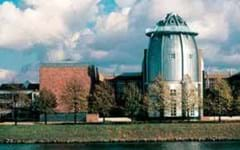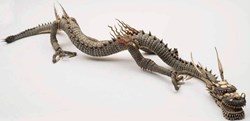Vetters
“WE are the TEFAF vetters. We receive no money – only travel expenses – but we are all about the works of art. For me and my colleagues, it is one of the most exciting days of the year.”
Henk van Os, Dutch art historian and a former director of the Rijksmuseum, has been chairman of vetting at TEFAF for a decade. A devoted Maastricht visitor for over 20 years, he has watched first hand the fair’s evolution from the smallscale Pictura show to its 89-dealer launch at the MECC in 1988.
His predecessor in the role, Robert Aronson, head of a century-old dealing dynasty, personally offered him the job at the 2007 fair. Rigorous vetting has always been a key tenet of TEFAF but on Van Os’ watch, the committee has evolved and the processes formalised. Old Masters dealer Johnny Van Haeften, this year celebrating 45 years in business, describes the current set up as “incredibly strict [and] unequivocally the strongest and most stringent in the world”. It is, he says, “very rare that anything slips through the net”.
Quality control at Maastricht in 2017 will involve around 175 international experts in 29 different disciplines (London’s Masterpiece fair boasts similar numbers).
The roster has morphed in recent years to reflect the changing nature of the fair. For example, as Italian and southern European pictures have begun to rival Dutch and Flemish works in both number and quality at TEFAF, the Old Masters committee has been divided in two. As Postwar art and design have become mainstream, so new personnel have followed.
And transparency has become key. To end any perceived conflict of interest, exhibiting dealers and auctioneers have, slowly but surely, left the committee.
‘An exciting reunion’
It all begins four days before the Friday opening of the fair. “We have the same ritual. On Monday evening we visit briefly before dinner. On Tuesday morning I arrive at around 8.30am. We split into the various committees and then meet again for dinner.” There is great camaraderie among colleagues who only meet once a year. “The atmosphere is always that of an exciting reunion,” Van Os says.
For the dealers, Wednesday afternoon is crunch time. They learn of any ‘casualties’ only when, invited back to their stands, they find items have been removed. Exhibitors have the right to appeal but, in cases where doubt persists over quality, authenticity or condition, the object is placed in locked storage for the duration of the fair.
Van Os concedes the procedure is not always popular – “we encounter everything from shouting to weeping,” he reveals – but few decisions are overturned. Committee heads are encouraged to write down their judgment precisely so there is little room for interpretation. They make no comment on price.
Re-labelling
Will there be more focus on fakes in the wake of a year when both Old Masters and 18th century French furniture came under the spotlight? The chairman agrees there will be. However, he anticipates most discussions will concern attribution and condition rather than simple questions of ‘right or wrong’.
There are no rules on where to draw the line but it is up to the committee to decide “how many newer elements are allowed until a 17th century cupboard is no longer 17th century”.
Most things, says Van Os, can be solved by re-labelling and, more often than not, it is a case of two schools of thought working together to find a description that both can live with. Where previously the dealers were trusted over provenance, TEFAF vetters will increasingly insist on an evidential record of ownership.
They are also encouraged to use, in tandem with their expertise and experience, the sophisticated technology now at their disposal. For four years, TEFAF has provided ‘on site’ access to Hirox digital microscopes, UV and infrared reflectography, direct digital radiography and X-ray fluorescence portable spectrometers.
Each committee must submit a written request to use the equipment under the supervision of Carol Pottasch, conservator at The Hague’s Mauritshuis, and staff from the Rijksmuseum.
“It was a big development,” says the chairman. “Some of the older members were of the view that the eye was always most important and asked if was really necessary? I told them there are some things that even your eye can’t see.”
Vetting at TEFAF begins on March 7.
Curriculum Vitae
Hendrik Willem van Os (b.1938)
1957
Studied History and History of Art, University of Groningen
1974
Professor of Art and Cultural History, University of Groningen
1989
Director of the Rijksmuseum
1990-96
1990-96 Presenter of Dutch TV show Beeldenstorm (Iconoclasm)
1996-2016
Professor of Art and Society at the University of Amsterdam
2008
Chairman of the TEFAF vetting committee


